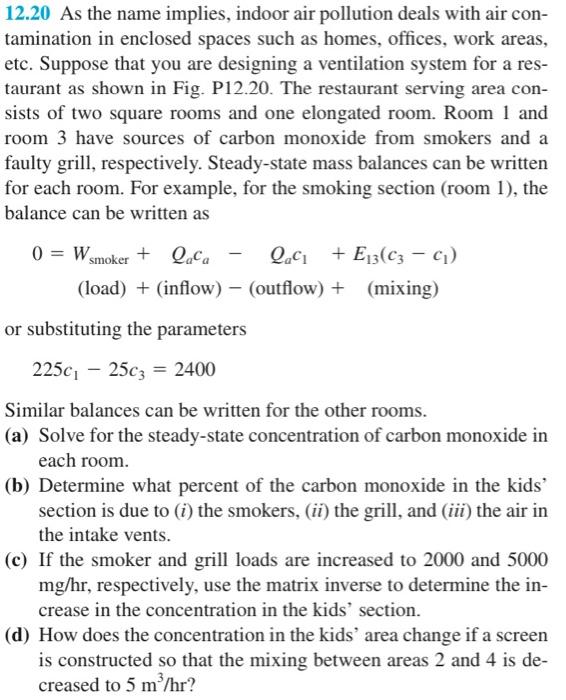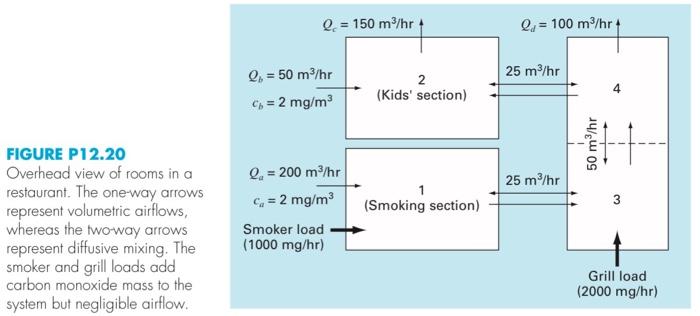(matlab code only)(matlab code only)(matlab code only)(matlab code only)(matlab code only)
here is problem!!!

Problem 12.20: For Part (a), you can cheat" and use x = A\b. Also, the diagram in the book is missing a few important arrows. Here are the four equations that you should be using for the steady-state mass balance in each room: Room 1: W, + Qaca Qac + E13(cz - c) = 0 Room 2: QC - Q.C2 + (Qa - Qace + E24(C4 - cy) = 0 Room 3: W, +Qa61 - Qa63 +E13(C1 cz) + E34(C4 - cz) = 0 Room 4: Qacz - Qacs + E34 (C3 - C) + E24C2 - Cx) = 0 12.20 As the name implies, indoor air pollution deals with air con- tamination in enclosed spaces such as homes, offices, work areas, etc. Suppose that you are designing a ventilation system for a res- taurant as shown in Fig. P12.20. The restaurant serving area con- sists of two square rooms and one elongated room. Room 1 and room 3 have sources of carbon monoxide from smokers and a faulty grill, respectively. Steady-state mass balances can be written for each room. For example, for the smoking section (room 1), the balance can be written as 0 = Wsmoker + Qaca Qc + E13(C3 - 9) (load) + (inflow) - (outflow) + (mixing) or substituting the parameters 2250 - 25c3 = 2400 Similar balances can be written for the other rooms. (a) Solve for the steady-state concentration of carbon monoxide in each room. (b) Determine what percent of the carbon monoxide in the kids? section is due to (i) the smokers, (ii) the grill, and (iii) the air in the intake vents. (c) If the smoker and grill loads are increased to 2000 and 5000 mg/hr, respectively, use the matrix inverse to determine the in- crease in the concentration in the kids' section. (d) How does the concentration in the kids' area change if a screen is constructed so that the mixing between areas 2 and 4 is de- creased to 5 m /hr? Q = 150 m/hr + 0,= 100 m/hr 25 m/hr Q, = 50 m3/hr C) = 2 mg/m 2 (Kids' section) 4 50 m/hr FH- 25 m/hr 3 FIGURE P12.20 Overhead view of rooms in a restaurant. The one-way arrows represent volumetric airflows, whereas the two-way arrows represent diffusive mixing. The smoker and grill loads add carbon monoxide mass to the system but negligible airflow. Q. = 200 m/hr C = 2 mg/m Smoker load (1000 mg/hr) (Smoking section) Grill load (2000 mg/hr) Problem 12.20: For Part (a), you can cheat" and use x = A\b. Also, the diagram in the book is missing a few important arrows. Here are the four equations that you should be using for the steady-state mass balance in each room: Room 1: W, + Qaca Qac + E13(cz - c) = 0 Room 2: QC - Q.C2 + (Qa - Qace + E24(C4 - cy) = 0 Room 3: W, +Qa61 - Qa63 +E13(C1 cz) + E34(C4 - cz) = 0 Room 4: Qacz - Qacs + E34 (C3 - C) + E24C2 - Cx) = 0 12.20 As the name implies, indoor air pollution deals with air con- tamination in enclosed spaces such as homes, offices, work areas, etc. Suppose that you are designing a ventilation system for a res- taurant as shown in Fig. P12.20. The restaurant serving area con- sists of two square rooms and one elongated room. Room 1 and room 3 have sources of carbon monoxide from smokers and a faulty grill, respectively. Steady-state mass balances can be written for each room. For example, for the smoking section (room 1), the balance can be written as 0 = Wsmoker + Qaca Qc + E13(C3 - 9) (load) + (inflow) - (outflow) + (mixing) or substituting the parameters 2250 - 25c3 = 2400 Similar balances can be written for the other rooms. (a) Solve for the steady-state concentration of carbon monoxide in each room. (b) Determine what percent of the carbon monoxide in the kids? section is due to (i) the smokers, (ii) the grill, and (iii) the air in the intake vents. (c) If the smoker and grill loads are increased to 2000 and 5000 mg/hr, respectively, use the matrix inverse to determine the in- crease in the concentration in the kids' section. (d) How does the concentration in the kids' area change if a screen is constructed so that the mixing between areas 2 and 4 is de- creased to 5 m /hr? Q = 150 m/hr + 0,= 100 m/hr 25 m/hr Q, = 50 m3/hr C) = 2 mg/m 2 (Kids' section) 4 50 m/hr FH- 25 m/hr 3 FIGURE P12.20 Overhead view of rooms in a restaurant. The one-way arrows represent volumetric airflows, whereas the two-way arrows represent diffusive mixing. The smoker and grill loads add carbon monoxide mass to the system but negligible airflow. Q. = 200 m/hr C = 2 mg/m Smoker load (1000 mg/hr) (Smoking section) Grill load (2000 mg/hr)










